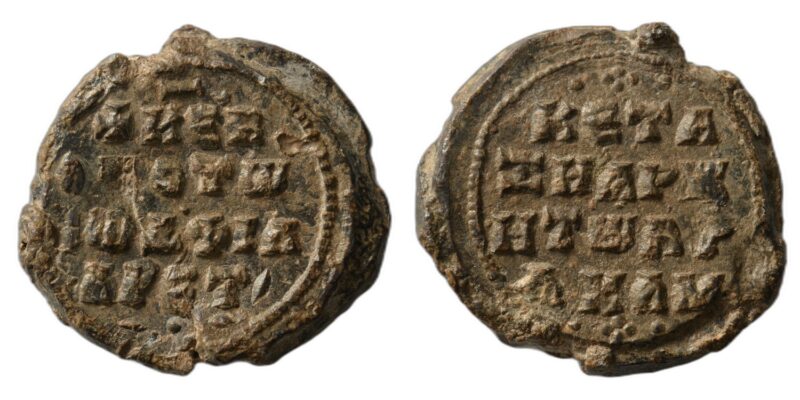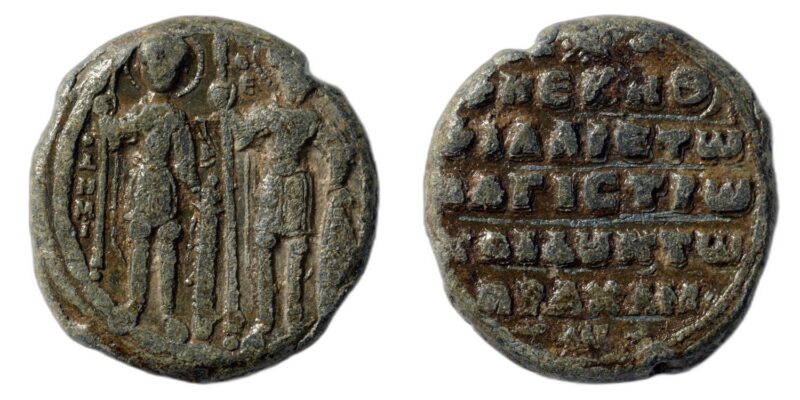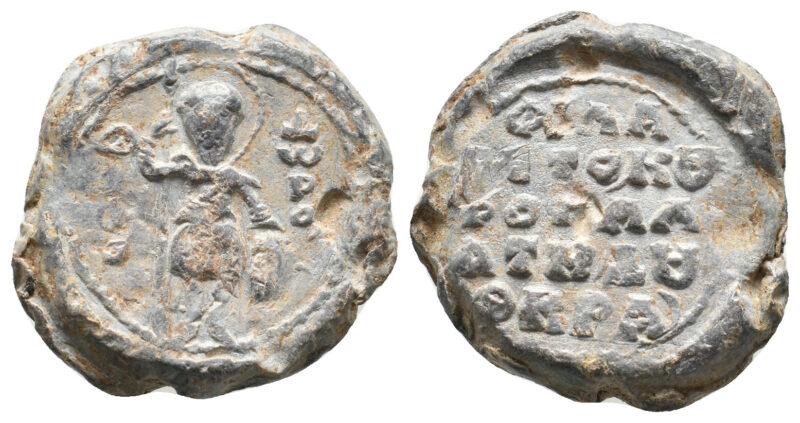Philaretos Brachamios, also known as Philaretos Varazhnuni [Փիլարտոս Վարաժնունի], was a significant military leader of Armenian descent in the Byzantine Empire during the 11th century. His life and career exemplify the turbulent political landscape of the era, marked by both internal Byzantine challenges and external pressures from emerging powers such as the Seljuk Turks.

Κύριε βοήθει τῷ σῷ δούλῳ Φιλαρέτῳ, τῷ ταξηάρχῃ τῷ Βραχαμίῳ.
Lord, help your servant Philaretos, the taxiarches of Brachamios.
Early Life and Military Career
Philaretos was born into the distinguished Varazhnuni family, renowned for their influence within the Byzantine military and administrative circles. This prestigious lineage, along with the political and social upheavals of his time, greatly shaped his early life and future career. He emerged as a skilled military strategist, known for his defensive tactics that leveraged the Byzantine Empire’s geographic strengths against external threats.
Philaretos served under Emperor Romanos IV Diogenes, playing a crucial role in the defense of Byzantine territories against the Seljuk Turks. His expertise in strategic formations, such as the Crescent and Fabian strategies, demonstrated his ability to innovate and adapt to the rapidly changing dynamics of medieval warfare.

Θεοτόκε βοήθει Φιλαρέτῳ μαγίστρῳ καὶ δουκὶ τῷ Βραχαμίῳ.
Mother of God, help Philaretos, the magistros and doux of Brachamios.
The Aftermath of Manzikert and Rise to Power
The Byzantine defeat at the Battle of Manzikert in 1071 was a turning point that led to the Empire’s weakened control over Anatolia and the rise of regional powers. In the chaotic aftermath, Philaretos capitalized on the power vacuum by establishing a quasi-autonomous Armenian principality in the region. Between 1078 and 1085, he built a domain stretching from Malatia in the north to Antioch in the south, and from Cilicia in the west to Edessa in the east.
This principality became a refuge for many Armenian nobles, whom Philaretos invited to settle in his territories, providing them with land and fortresses. His actions not only consolidated Armenian power in the region but also temporarily halted the Seljuk advance, creating a buffer zone that protected the remaining Byzantine territories from further incursions.

Φιλαρέτῳ κουροπαλάτῃ δούκᾳ, ὁ Βραχάμης.
To Philaretos, the Kouropalates and Doux, the Brachamios.
Establishing an Armenian State
Philaretos’s principality was a significant development in the history of Armenian statehood during a period of foreign domination and fragmentation. By forming a strong Armenian state, he laid the groundwork for the future establishment of the Armenian Kingdom of Cilicia, which would emerge as a key political entity in the region. His leadership attracted Armenian settlers and fortified the cultural and political influence of Armenians in the Near East.
Despite its eventual disintegration following his death in 1090, Philaretos’s principality represented a resurgence of Armenian autonomy and military might in the medieval period. It served as a precursor to the later Armenian Kingdom of Cilicia, which played a pivotal role in regional politics during the Crusades.
Legacy
Philaretos Brachamios is remembered as a skilled military leader and an astute statesman whose actions significantly impacted Byzantine-Armenian relations. His principality exemplified the potential for Armenian self-governance in the medieval era and underscored the resilience of Armenian political structures amidst external threats and internal discord.
His contributions to the Byzantine military and his role in establishing an Armenian state continue to be subjects of academic interest, reflecting the intricate interplay between military innovation and the historical context of the Byzantine Empire. The story of Philaretos Brachamios illustrates the complexities of power, identity, and survival in the medieval Near East, offering insights into the broader narrative of Armenian and Byzantine history.
To see more seals of Philaretos Brachamios, visit the catalog section here.
References:
- “Philaretos Brachamios.” Wikipedia: The Free Encyclopedia. Wikimedia Foundation, n.d. Web. Accessed 3 Aug. 2024. https://en.wikipedia.org/wiki/Philaretos_Brachamios.
- “Armenian Kingdom of Cilicia.” Wikipedia: The Free Encyclopedia. Wikimedia Foundation, n.d. Web. Accessed 3 Aug. 2024. https://en.wikipedia.org/wiki/Armenian_Kingdom_of_Cilicia.
- “Prologue.” History Maps. n.d. Web. Accessed 3 Aug. 2024. https://history-maps.com.
- “Kogh Vasil.” Wikipedia: The Free Encyclopedia. Wikimedia Foundation, n.d. Web. Accessed 3 Aug. 2024. https://en.wikipedia.org/wiki/Kogh_Vasil.
- “Փիլարտոս Վարաժնունի” (Philaretos Varazhnuni). Վիքիպեդիա (Wikipedia: The Free Encyclopedia). Wikimedia Foundation, n.d. Web. Accessed 3 Aug. 2024. https://hy.wikipedia.org/wiki/Փիլարտոս_Վարաժնունի.
- Shandrovskaia, V. S. “The Seals of Philaretos Vrakhamios (Varazhnuni) in the Hermitage / Эрмитажные печати Филарета Врахамия (Варажнуни).” Lraber Hasarakakan Gitutyunneri / Լրաբեր հասարակականգիտությունների / Herald of the Social Sciences, vol. XXXVI, no. 3, 1975, pp. 36–49. ANBL-1176.
- Cheynet, Jean-Claude. “Les Brachamioi.” La société byzantine, vol. 2, 2008, pp. 377–412.
